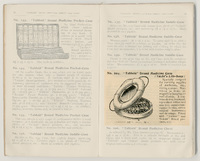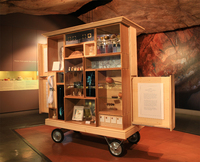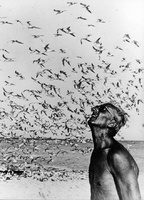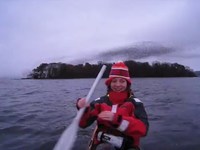Items
Site
The Medicine Chest
keywords is exactly
boat
-

Navigation chart, Micronesia
"Early Pacific seafarers did not have scientific instruments or conventional European-style maps to voyage to, and settle, the thousands of islands of Micronesia and Polynesia. Instead they used the movement of the sea, the direction of the wind, the position of the sun and stars, and the flight of birds. This is a navigation chart, obtained by Georg Irmer, the Governor of the Marshall Islands from Chief Nalu of Jaluit atoll in 1896. The strips of wood, bound by cane, represent the currents and winds, and the six small, white shells represent islands". -

Moor
Installation. Material provided by family and friends. As of 08/18/2009, Moor is 326.9 feet long (99.63 meters). Moor will continue to grow. -

Moor
Installation. Material provided by family and friends. As of 08/18/2009, Moor is 326.9 feet long (99.63 meters). Moor will continue to grow. -

Whalesharks (Fiction/Fact)
Whale sharks (Rhincodon typus) are the largest shark, and indeed largest of any fishes alive today. These gentle marine giants roam the oceans around the globe, generally alone. They only feed on plankton. In the Norwegian explorer, Thor Theyerdal's account of his journey by raft across the Pacific Ocean from South America to the Polynesian islands in 1947, the crew is visited by one of these curious and benign creatures: "In reality the whale shark went on encircling us for barely an hour, but to us the visit seemed to last a whole day. At last it became too exciting for Erik, who was standing at a corner of the raft with an eight-foot hand harpoon, and, encouraged by ill-considered shouts, he raised the harpoon above his head. As the whale shark came gliding slowly toward him and its broad head moved right under the corner of the raft, Erik thrust the harpoon with all his giant strength down between his legs and deep into the whale shark’s gristly head. It was a second or two before the giant understood properly what was happening. Then in a flash the placid half-wit was transformed into a mountain of steel muscles. We heard a swishing noise as the harpoon line rushed over the edge of the raft and saw a cascade of water as the giant stood on its head and plunged down into the depths. The three men who were standing nearest were flung about the place, head over heels, and two of them were flayed and burned by the line as it rushed through the air. The thick line, strong enough to hold a boat, was caught up on the side of the raft but snapped at once like a piece of twine, and a few seconds later a broken-off harpoon shaft came up to the surface two hundred yards away" . -

Walter Floyd arrives by boat
"The BWC shop was located a short walk from Walter Floyd’s dental practice which he bought in 1904 (for £2,404 16s 8d) and shared with his partner, William Johnston. It is uncertain when Floyd first came out to South Africa, but records prove that he was living here by January 1902 (Hart & Lydall, 1981: 1)" (Liebenberg 2021: 52). In interviews with Mary Floyd in 2015, I showed her this photo of her father-in-law on the boat, en route to Cape Town, and asked her whether she knew who the woman in the photo was. (She appeared in quite a few photos of Floyd's from this period – one especially intimate one showing her lying on a beach and smiling coyly at the photographer.) Was it Agnes, perhaps? She said it definitely wasn't. -

Pier 59
A monumental installation piece recreating the ocean liner Titanic as a floating deck plan (in its original size – 882 feet long; 92 feet wide), projected in light onto the surface of the Hudson River at Pier 59 (due west of West 18th Street), the ship's intended destination in 1912. -

Echolocation (Part one)
In the spring of 1940, Steinbeck and his very close friend, biologist Ed Ricketts, chartered a boat and embarked on a month long marine specimen-collecting expedition in the Gulf of California, which resulted in their collaboration on a book, 'The Sea of Cortez'. Described as both a travelogue and biological record, it reveals the two men's philosophies: it dwells on the place of humans in the environment, the interconnection between single organisms and the larger ecosystem, and the themes of leaving and returning home. A number of ecological concerns, rare in 1940, are voiced, such as an imagined but horrific vision of the long term damage that the Japanese bottom fishing trawlers are doing to the sea bed. Although written as if it were the journal kept by Steinbeck during the voyage, the book is to some extent a work of fiction: the journals are not Steinbeck's, and his wife, who had accompanied him on the trip, is not mentioned (though at one point Steinbeck slips and mentions the matter of food for seven people). Since returning home is a theme throughout the narrative, the inclusion of his wife, a symbol of home, would have dissipated the effect. Steinbeck and Ricketts are never mentioned by name but are amalgamated into the first person "we" who narrate the log. -

The Memory of Water
"Of the cases used during Stanley's famous travels, the "Rear Guard" 'Tabloid' Medicine Chest is worthy of special mention. The chest remained in the swamp regions of the Aruwhimi for nearly four years, and more than once was actually submerged in the river. Notwithstanding these mishaps, when the chest was brought back to London and the remaining contents tested by the Official Analyst of the Lancet, they were found to have retained their efficacy "(BWC 1934: 5). -

Iroko
Structurally, 'Chest: a botanical ecology' consisted of 15 modular interlocking cabinets of differing sizes which rested on top of one another, making up the front of the display. These were constructed from two types of wood, the darker iroko wood, and a lighter ash wood – with the iroko originating from the repurposed cabinets used for Curiosity CLXXV in 2004. The Iroko tree is a large hardwood tree from the west coast of tropical Africa, known by the Yoruba as ìrókò, logo or loko. Believed to have supernatural properties, it can live up to 500 years. Yoruba people believe that a spirit inhabits the tree, and anybody who sees the Iroko-man face to face becomes insane and dies. According to the Yoruba, any man who cuts down any Iroko tree causes devastating misfortune on himself and all of his family. In West Africa, the iroko wood is also used to make the djembe drum. If they however, need to cut down the tree, they can make a prayer afterwards to protect themselves. Used for a variety of purposes including boat-building, domestic flooring, furniture and outdoor gates, from the late 1990s, it was also used as part of the txalaparta, a Basque musical instrument constructed of wooden boards, due to its lively sound and classified as an idiophone (a percussion instrument) (Ogumfe 1929: online)). -

Seeds of Change
"'Seeds of Change' is an ongoing investigation based on original research of ballast flora in the port cities of Europe. Projects have been developed for Marseilles, Reposaari, Dunkirk, Exeter and Topsham, Liverpool and Bristol. Material such as stones, earth, sand, wood, bricks and whatever else was economically expedient was used as ballast to stabilize merchant sailing ships according to the weight of the cargo. Upon arrival in port, the ballast was unloaded, carrying with it seeds native to the area where it had been collected. The source of these seeds can be any of the ports and regions (and their regional trading partners) involved in trade with Europe. The botanist, Dr. Heli Jutila, an expert on ballast flora writes, 'Although seeds seem to be dead, they are in fact alive and can remain vital in soil for decades, and even hundreds of years in a state of dormancy'. Seeds contained in ballast soil may germinate and grow, potentially bearing witness to a far more complex narrative of world history than is usually presented by orthodox accounts" (Alves 2021). -

The Sea Birds of Isabella
Aired between 1968 and 1976, 'The Undersea World of Jacques Cousteau' was a documentary television series about underwater marine life. It was directed by Alan Landsburg and hosted by French filmmaker, researcher, and marine explorer Jacques Cousteau. In the 33rd episode of the series, titled 'The Sea Birds of Isabella', the crew journeys off the coast of Mexico to an island to study its tropical birds. Three years after it was shown, Cousteau's son, Phillipe (then aged 38) died trying to land his seaplane, called the Flying Calypso, on the Taos River in Portugal. -

Museum of Natural History Oxford
On a sunny afternoon, July 4th 1862, an Oxford don took out four friends, for a rowing expedition up the Thames. The don was the Oxford mathematician, photographer and storyteller, Charles Dodgeson (better known by his pen name, Lewis Carroll) and his friends were the Rev. Robinson Duckworth and three children – Alice Liddell, aged 10, and her sisters. During the afternoon Dodgeson spun out a series of fantastic yarns incorporating friends and familiar places in Oxford, mathematical riddles, literary allusions and countless references to natural history. -

The Memory of Water
Of the cases used during Stanley's famous travels, the Rear Guard 'Tabloid' Medicine Chest is worthy of special mention. The chest remained in the swamp regions of the Aruwhimi for nearly four years, and more than once was actually submerged in the river. Notwithstanding these mishaps, when the chest was brought back to London and the remaining contents tested by the Official Analyst of the Lancet, they were found to have retained their efficacy (BWC 1934: 5). -

The Green Ray (Jay Gatsby)
“Gatsby believed in the green light, The orgiastic future that year by year recedes before us. It eludes us then, but that’s no matter – to-morrow we will run faster, stretch out our arms further... And one fine morning – So we beat on, boats against the current, borne back ceaselessly into the past” (Fitzgerald 1983: 188). -

Murmeration
A short film that follows the journey of two girls in a canoe on the River Shannon and how they stumble across one of nature's greatest phenomenons; a murmuration of starlings.


